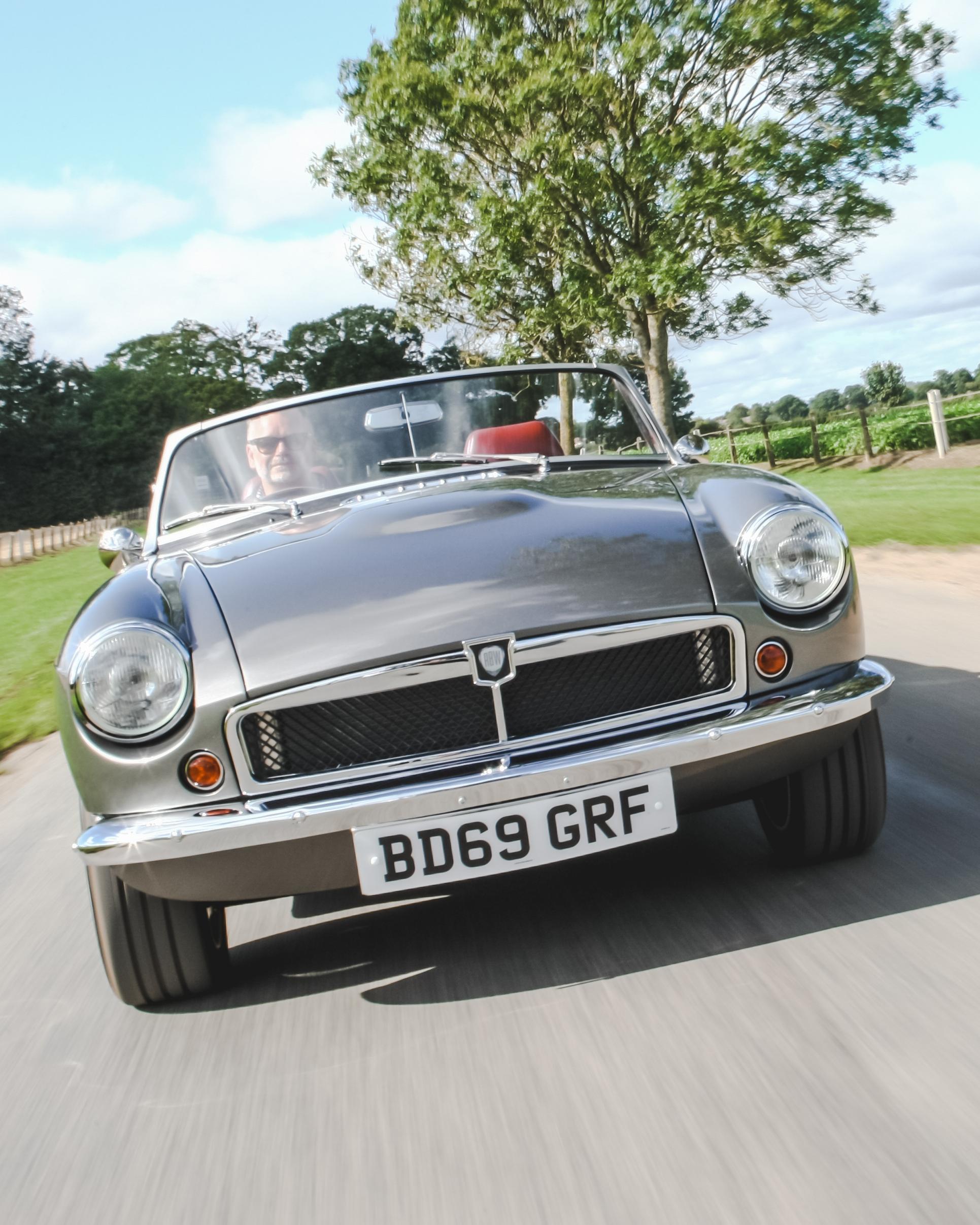The Timeless Art of Classic Car Restoration
The Timeless Art of Classic Car Restoration

Classic cars are a timeless piece of history that have captured the hearts of car enthusiasts all around the world. Whether it's the sleek curves of a '57 Chevy or the roaring engine of a Mustang, classic cars hold a special place in the hearts of many. However, as these vintage vehicles age, they require more care and maintenance to keep them running smoothly. In this article, we'll explore the process of classic car restoration, from finding parts to maintaining the finished product.
Where to Look for your Classic Car
The first step in restoring a classic car is finding the right one to work on. This can be done in several ways, including searching classified ads, attending car shows and auctions, and talking to other car enthusiasts. It's important to keep in mind that some classic cars are harder to find than others, so be prepared to do some digging.
There are several popular car shows and auctions where classic car enthusiasts can find their dream cars. Here are some of the most famous ones:
-
Barrett-Jackson Auctions, held annually in Scottsdale, Arizona. The auction attracts collectors and enthusiasts from all over the world, and features some of the rarest and most valuable classic cars.
-
Goodwood Revival, an annual vintage car race held in West Sussex, England, and it's one of the most glamorous events on the classic car calendar. The race features cars from the 1940s, 50s, and 60s, and it's attended by some of the biggest names in the classic car world.
-
Pebble Beach Concours d'Elegance, one of the most prestigious classic car shows in the world, and it's held annually in Pebble Beach, California. The show features some of the most beautiful and rarest classic cars.
-
Amelia Island Concours d'Elegance, another prestigious classic car show held annually in Amelia Island, Florida.
-
Hershey AACA Fall Meet, the largest antique car show in the world held annually in Hershey, Pennsylvania. The show features over 10,000 cars.
Classic cars are a timeless piece of history that have captured the hearts of car enthusiasts all around the world. Whether it's the sleek curves of a '57 Chevy or the roaring engine of a Mustang, classic cars hold a special place in the hearts of many. However, as these vintage vehicles age, they require more care and maintenance to keep them running smoothly. In this article, we'll explore the process of classic car restoration, from finding parts to maintaining the finished product.
Where to Look for your Classic Car
The first step in restoring a classic car is finding the right one to work on. This can be done in several ways, including searching classified ads, attending car shows and auctions, and talking to other car enthusiasts. It's important to keep in mind that some classic cars are harder to find than others, so be prepared to do some digging.
There are several popular car shows and auctions where classic car enthusiasts can find their dream cars. Here are some of the most famous ones:
-
Barrett-Jackson Auctions, held annually in Scottsdale, Arizona. The auction attracts collectors and enthusiasts from all over the world, and features some of the rarest and most valuable classic cars.
-
Goodwood Revival, an annual vintage car race held in West Sussex, England, and it's one of the most glamorous events on the classic car calendar. The race features cars from the 1940s, 50s, and 60s, and it's attended by some of the biggest names in the classic car world.
-
Pebble Beach Concours d'Elegance, one of the most prestigious classic car shows in the world, and it's held annually in Pebble Beach, California. The show features some of the most beautiful and rarest classic cars.
-
Amelia Island Concours d'Elegance, another prestigious classic car show held annually in Amelia Island, Florida.
-
Hershey AACA Fall Meet, the largest antique car show in the world held annually in Hershey, Pennsylvania. The show features over 10,000 cars.
How to Choose the Right Classic Car
When it comes to classic cars, some models are easier to maintain than others due to their simplicity of design, availability of parts, and overall reliability. On the other hand, some classic cars can be quite challenging to maintain due to their rarity, complexity, and the scarcity of parts. Here are a few examples.
Easiest to maintain
-
Ford Mustang: This car was introduced in 1964 and quickly became a cultural icon. It was a sporty and affordable car that was powered by a range of engines, including a 289 cubic inch V8. The Mustang is one of the most popular classic cars in the world, with a huge fan base and a wealth of resources available for maintenance and repair.
-
Chevrolet Corvette: The Corvette is another classic American car with a devoted following and an abundance of parts and resources available. This car was introduced in 1963 and is one of the most recognizable American sports cars. It had a distinctive design and was powered by a range of engines, including a 427 cubic inch V8.
-
Volkswagen Beetle: The car was first introduced in 1938 in Nazi Germany as a "people's car" or "Volkswagen" in German, designed to be affordable and accessible to everyone. Despite its humble beginnings, the Beetle went on to become one of the most popular and beloved cars in history. The car's simple construction means that most parts are readily available and relatively affordable. The Volkswagen brand also has a large following, which means that there is a lot of support and knowledge available to help owners keep their Beetles in top condition.
Most difficult to maintain:
-
Ferrari 250 GTO: This car is considered by many to be the ultimate classic car. Only 39 were ever built between 1962 and 1964, and they are highly prized by collectors. In 2018, one sold for a record-breaking $70 million. The Ferrari 250 GTO is notoriously difficult to maintain due to its complex and finely-tuned mechanics, as well as the scarcity of parts.
-
Mercedes-Benz 300SL Gullwing: Another highly sought-after classic car, the 300SL Gullwing is a marvel of engineering and design, but its intricate mechanical systems make it a challenging car to maintain. This car was introduced in 1954 and is known for its distinctive gull-wing doors. It was the fastest production car of its time, with a top speed of 161 mph. Only 1,400 were ever built, making it a rare and valuable classic car.
-
Jaguar E-Type: This car was introduced in 1961 and is considered one of the most beautiful cars ever made. It had a sleek and aerodynamic body and was powered by a 3.8-liter inline-six engine. Its advanced mechanical systems and notoriously fickle electrical systems make it a difficult car to keep in top condition.
Of course, the ease or difficulty of maintaining a classic car can also depend on the specific model, the availability of parts, and the expertise of the owner or mechanic. Ultimately, it's important to do your research and understand the unique needs of any classic car before embarking on a restoration or maintenance project.
Restoring a Classic Car
Once you've found the right car, it's important to inspect it thoroughly to determine the extent of restoration needed. This includes checking for rust, body damage, and any mechanical issues. It's also important to make sure that the car's VIN (Vehicle Identification Number) matches the paperwork to avoid any legal issues down the line.
Then it's time to start the restoration process. This includes everything from replacing parts to repainting the body. While some car enthusiasts prefer to do the work themselves, others opt to hire a professional restoration service. Either way, it's important to have a solid plan in place and to work systematically to avoid any issues.
One of the most challenging aspects of classic car restoration is finding the right parts. Many parts for classic cars are no longer in production, so enthusiasts must rely on salvage yards, online marketplaces, and specialty manufacturers to find what they need. It's important to do research and work with reputable sellers to ensure that you're getting high-quality parts.
Maintaining a Classic Car
Once the restoration process is complete, it's important to maintain the classic car to keep it in top condition. This includes regular tune-ups, oil changes, and inspections to ensure that everything is working as it should be. It's also important to keep the car clean and dry to avoid rust and other damage.
One important aspect of maintaining a classic car is proper storage. Many classic cars are only driven during certain times of the year, so it's important to store them properly during the off-season. This includes using a car cover to protect the body and making sure that the car is stored in a dry, climate-controlled space.
For instance, any classic convertibles are only driven during the warm summer months, as they are not designed for colder or wetter weather. Muscle cars are often driven during the summer months, as they are designed for high performance and warm weather conditions. Vintage race cars are typically only driven during racing season, which can vary depending on the location and type of racing. Classic sports cars, such as Porsche and Jaguar models, may be driven year-round in mild climates, but in colder areas they are typically only driven during the summer months.
The Price Tag in Question
The cost of a muscle car can vary widely depending on the make, model, year, condition, and rarity. Generally speaking, you can find a muscle car for anywhere from $10,000 to well over $100,000. Rare models or those in pristine condition can fetch even higher prices at auctions or private sales.
As for maintenance costs, it depends on the extent of the restoration and the level of care given to the vehicle. Routine maintenance items such as oil changes, tune-ups, and brake replacements are generally affordable. However, if the car requires major repairs or restoration work, the costs can add up quickly.
For example, a full engine rebuild can cost several thousand dollars, and replacing rare or hard-to-find parts can also be expensive. The cost of regular maintenance and repairs can be mitigated by performing some tasks yourself if you have the knowledge and tools, and by using reputable mechanics and parts suppliers who specialize in classic cars.
Conclusion
Classic car restoration is a labor of love that requires patience, skill, and dedication. Whether you're looking to restore a vintage Mustang or a classic Corvette, the process of bringing a piece of history back to life is both challenging and rewarding. With the right resources and a solid plan in place, you can restore a classic car to its former glory and enjoy the ride for years to come.
How to Choose the Right Classic Car
When it comes to classic cars, some models are easier to maintain than others due to their simplicity of design, availability of parts, and overall reliability. On the other hand, some classic cars can be quite challenging to maintain due to their rarity, complexity, and the scarcity of parts. Here are a few examples.
Easiest to maintain
-
Ford Mustang: This car was introduced in 1964 and quickly became a cultural icon. It was a sporty and affordable car that was powered by a range of engines, including a 289 cubic inch V8. The Mustang is one of the most popular classic cars in the world, with a huge fan base and a wealth of resources available for maintenance and repair.
-
Chevrolet Corvette: The Corvette is another classic American car with a devoted following and an abundance of parts and resources available. This car was introduced in 1963 and is one of the most recognizable American sports cars. It had a distinctive design and was powered by a range of engines, including a 427 cubic inch V8.
-
Volkswagen Beetle: The car was first introduced in 1938 in Nazi Germany as a "people's car" or "Volkswagen" in German, designed to be affordable and accessible to everyone. Despite its humble beginnings, the Beetle went on to become one of the most popular and beloved cars in history. The car's simple construction means that most parts are readily available and relatively affordable. The Volkswagen brand also has a large following, which means that there is a lot of support and knowledge available to help owners keep their Beetles in top condition.
Most difficult to maintain:
-
Ferrari 250 GTO: This car is considered by many to be the ultimate classic car. Only 39 were ever built between 1962 and 1964, and they are highly prized by collectors. In 2018, one sold for a record-breaking $70 million. The Ferrari 250 GTO is notoriously difficult to maintain due to its complex and finely-tuned mechanics, as well as the scarcity of parts.
-
Mercedes-Benz 300SL Gullwing: Another highly sought-after classic car, the 300SL Gullwing is a marvel of engineering and design, but its intricate mechanical systems make it a challenging car to maintain. This car was introduced in 1954 and is known for its distinctive gull-wing doors. It was the fastest production car of its time, with a top speed of 161 mph. Only 1,400 were ever built, making it a rare and valuable classic car.
-
Jaguar E-Type: This car was introduced in 1961 and is considered one of the most beautiful cars ever made. It had a sleek and aerodynamic body and was powered by a 3.8-liter inline-six engine. Its advanced mechanical systems and notoriously fickle electrical systems make it a difficult car to keep in top condition.
Of course, the ease or difficulty of maintaining a classic car can also depend on the specific model, the availability of parts, and the expertise of the owner or mechanic. Ultimately, it's important to do your research and understand the unique needs of any classic car before embarking on a restoration or maintenance project.
Restoring a Classic Car
Once you've found the right car, it's important to inspect it thoroughly to determine the extent of restoration needed. This includes checking for rust, body damage, and any mechanical issues. It's also important to make sure that the car's VIN (Vehicle Identification Number) matches the paperwork to avoid any legal issues down the line.
Then it's time to start the restoration process. This includes everything from replacing parts to repainting the body. While some car enthusiasts prefer to do the work themselves, others opt to hire a professional restoration service. Either way, it's important to have a solid plan in place and to work systematically to avoid any issues.
One of the most challenging aspects of classic car restoration is finding the right parts. Many parts for classic cars are no longer in production, so enthusiasts must rely on salvage yards, online marketplaces, and specialty manufacturers to find what they need. It's important to do research and work with reputable sellers to ensure that you're getting high-quality parts.
Maintaining a Classic Car
Once the restoration process is complete, it's important to maintain the classic car to keep it in top condition. This includes regular tune-ups, oil changes, and inspections to ensure that everything is working as it should be. It's also important to keep the car clean and dry to avoid rust and other damage.
One important aspect of maintaining a classic car is proper storage. Many classic cars are only driven during certain times of the year, so it's important to store them properly during the off-season. This includes using a car cover to protect the body and making sure that the car is stored in a dry, climate-controlled space.
For instance, any classic convertibles are only driven during the warm summer months, as they are not designed for colder or wetter weather. Muscle cars are often driven during the summer months, as they are designed for high performance and warm weather conditions. Vintage race cars are typically only driven during racing season, which can vary depending on the location and type of racing. Classic sports cars, such as Porsche and Jaguar models, may be driven year-round in mild climates, but in colder areas they are typically only driven during the summer months.
The Price Tag in Question
The cost of a muscle car can vary widely depending on the make, model, year, condition, and rarity. Generally speaking, you can find a muscle car for anywhere from $10,000 to well over $100,000. Rare models or those in pristine condition can fetch even higher prices at auctions or private sales.
As for maintenance costs, it depends on the extent of the restoration and the level of care given to the vehicle. Routine maintenance items such as oil changes, tune-ups, and brake replacements are generally affordable. However, if the car requires major repairs or restoration work, the costs can add up quickly.
For example, a full engine rebuild can cost several thousand dollars, and replacing rare or hard-to-find parts can also be expensive. The cost of regular maintenance and repairs can be mitigated by performing some tasks yourself if you have the knowledge and tools, and by using reputable mechanics and parts suppliers who specialize in classic cars.
Conclusion
Classic car restoration is a labor of love that requires patience, skill, and dedication. Whether you're looking to restore a vintage Mustang or a classic Corvette, the process of bringing a piece of history back to life is both challenging and rewarding. With the right resources and a solid plan in place, you can restore a classic car to its former glory and enjoy the ride for years to come.

























